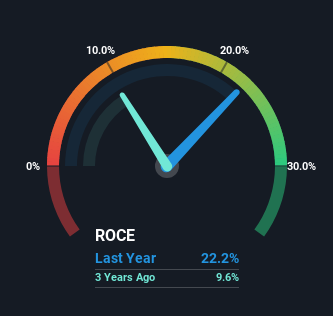- India
- /
- Metals and Mining
- /
- NSEI:USHAMART
Investors Should Be Encouraged By Usha Martin's (NSE:USHAMART) Returns On Capital
What trends should we look for it we want to identify stocks that can multiply in value over the long term? Typically, we'll want to notice a trend of growing return on capital employed (ROCE) and alongside that, an expanding base of capital employed. This shows us that it's a compounding machine, able to continually reinvest its earnings back into the business and generate higher returns. So when we looked at the ROCE trend of Usha Martin (NSE:USHAMART) we really liked what we saw.
What Is Return On Capital Employed (ROCE)?
For those that aren't sure what ROCE is, it measures the amount of pre-tax profits a company can generate from the capital employed in its business. Analysts use this formula to calculate it for Usha Martin:
Return on Capital Employed = Earnings Before Interest and Tax (EBIT) ÷ (Total Assets - Current Liabilities)
0.22 = ₹5.5b ÷ (₹31b - ₹6.7b) (Based on the trailing twelve months to December 2023).
Therefore, Usha Martin has an ROCE of 22%. In absolute terms that's a great return and it's even better than the Metals and Mining industry average of 14%.
See our latest analysis for Usha Martin

In the above chart we have measured Usha Martin's prior ROCE against its prior performance, but the future is arguably more important. If you're interested, you can view the analysts predictions in our free report on analyst forecasts for the company.
What Can We Tell From Usha Martin's ROCE Trend?
Usha Martin has not disappointed in regards to ROCE growth. We found that the returns on capital employed over the last five years have risen by 154%. That's a very favorable trend because this means that the company is earning more per dollar of capital that's being employed. In regards to capital employed, Usha Martin appears to been achieving more with less, since the business is using 28% less capital to run its operation. If this trend continues, the business might be getting more efficient but it's shrinking in terms of total assets.
In another part of our analysis, we noticed that the company's ratio of current liabilities to total assets decreased to 21%, which broadly means the business is relying less on its suppliers or short-term creditors to fund its operations. Therefore we can rest assured that the growth in ROCE is a result of the business' fundamental improvements, rather than a cooking class featuring this company's books.
What We Can Learn From Usha Martin's ROCE
From what we've seen above, Usha Martin has managed to increase it's returns on capital all the while reducing it's capital base. And with the stock having performed exceptionally well over the last five years, these patterns are being accounted for by investors. In light of that, we think it's worth looking further into this stock because if Usha Martin can keep these trends up, it could have a bright future ahead.
Usha Martin does have some risks though, and we've spotted 1 warning sign for Usha Martin that you might be interested in.
Usha Martin is not the only stock earning high returns. If you'd like to see more, check out our free list of companies earning high returns on equity with solid fundamentals.
New: AI Stock Screener & Alerts
Our new AI Stock Screener scans the market every day to uncover opportunities.
• Dividend Powerhouses (3%+ Yield)
• Undervalued Small Caps with Insider Buying
• High growth Tech and AI Companies
Or build your own from over 50 metrics.
Have feedback on this article? Concerned about the content? Get in touch with us directly. Alternatively, email editorial-team (at) simplywallst.com.
This article by Simply Wall St is general in nature. We provide commentary based on historical data and analyst forecasts only using an unbiased methodology and our articles are not intended to be financial advice. It does not constitute a recommendation to buy or sell any stock, and does not take account of your objectives, or your financial situation. We aim to bring you long-term focused analysis driven by fundamental data. Note that our analysis may not factor in the latest price-sensitive company announcements or qualitative material. Simply Wall St has no position in any stocks mentioned.
About NSEI:USHAMART
Usha Martin
Manufactures and sells steel wires, strands, wire ropes, and cord related accessories in India and internationally.
Flawless balance sheet with reasonable growth potential.
Similar Companies
Market Insights
Community Narratives




